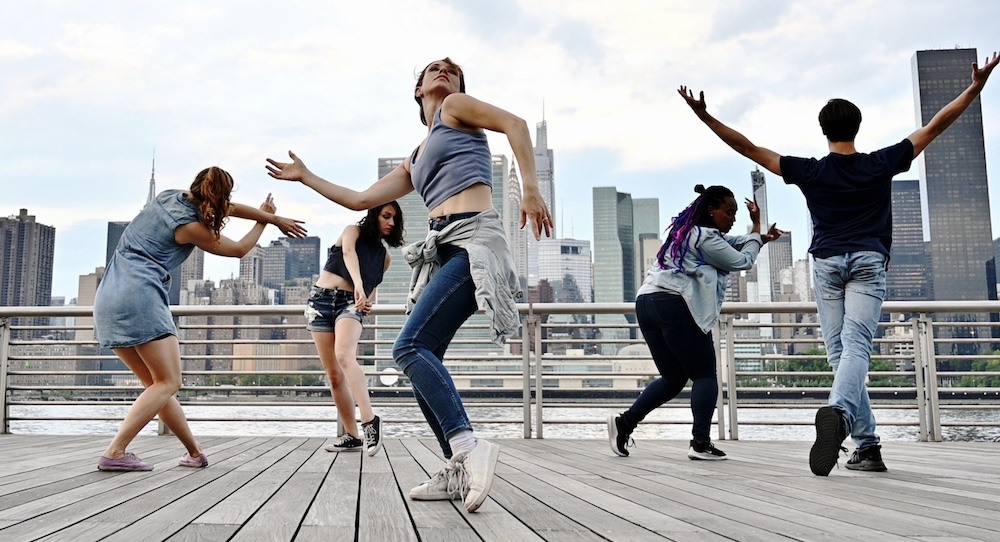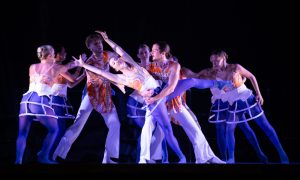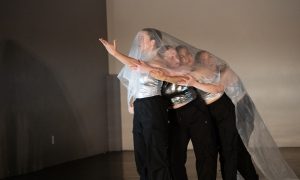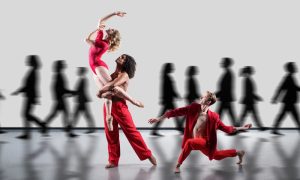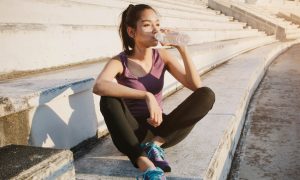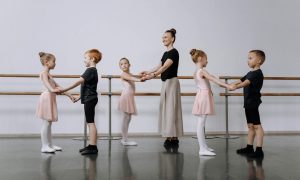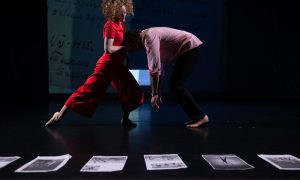July 27, 2021.
Streaming on YouTube.
Sirens blaring, the streets eerily empty, the smell of hand sanitizer and disinfectant in the air, the four walls of one’s small apartment all too familiar — COVID certainly changed the day-to-day, moment-by-moment experience of life in a city like New York City. Artists stand in the limelight and create things via their own self-expression, yet do we really know the people behind the artists? These two separate dynamics were clear in ALMA NYC‘s film, PLACES: A Look Behind the Curtain.
The program featured the artists of the company, and its Artistic Director Zanza Steinberg, sharing their experiences of the past year-and-a-half, including the COVID pandemic and social justice uprisings — through interviews, short dances on film, and depictions of experiences that brought movement and speech together. Their sharing and dancing notably vulnerable, attuned, and honest, it brought us into their experience and encouraged an investigation of our own.
Toward the beginning of the program, company artists shared their experiences of COVID’s onset — including ways they could connect and ways in which they were precluded from connecting with their creative community through that time. With voiceover from Steinberg describing the feeling of needing to move and to create, Kaitlin Niewoehner moved on a bridge structure alone.
She danced expansively yet with assured grounding, with technical prowess — yet also just as much presence and care towards quieter moments in movement. Following that was a section more pedestrian but with just as much emotional weight and memorable visuals — Steinberg walking, the camera panning down on her sneakers moving her through quiet NYC streets, then to spellbinding NYC skyline views. She recounted the experience of those frightening, uncertain early days of the pandemic in New York City, in more voiceover, all throughout. Sensory language like the continuous sound of sirens brought this atmosphere to life.
Then came the first group dance section of the program, an effective transition from the emotionally weighty sections that preceded it. Poignant and evocative, the section raised questions of how we can and can’t connect when physical closeness isn’t possible.
The dancers moved together in a vast space, yet didn’t interact. The uncertainty and foreboding in the score layered those feelings on to the movement and its context. A moment highlighting each of them, simply facing the camera individually, underscored the humanity underlying all of the tumult and frightening uncertainty.
The artists executed the contemporary ballet vocabulary with striking focus and intentionality. Just as in Niewoehner’s solo, the section demonstrated the power of a simple gesture — that which can be just as impactful as virtuosic movement, when offered with full presence and emotional honesty.
“You can’t talk about 2020 without talking about George Floyd,” affirmed Steinberg in another voiceover — layered on top of vivid images of New York City-based Black Lives Matter protests. Three artists of color in the company then shared their experiences of these social justice uprisings, as well as nuanced thoughts and feelings on representation, tokenism, and equality of opportunity — never sugarcoating how they think and feel but also extending remarkable grace and thoughtfulness in their thinking and speech.
In an uplifting turn, company artists described the “We Keep Moving” campaign of mid-2020, featuring company dancers sharing their daily movement practice through COVID in an encouragement to help the company stay fiscally sustainable. Interspersed were shots of them taking class together over Zoom. With a little laugh, “we’re getting really good at picking up really intricate choreography over Zoom,” Steinberg noted from her Zoom square.
Continuing the hopeful tone at hand, Davonna Batt and Justin Campbell danced a moving section illustrating the experience of being able to be in close space together again following vaccination against COVID. Wearing simple denim and white shirts, they danced in front of a large, open white wall. At first they moved apart and wore masks — yet later on they took those off. Cautiously but assuredly, they came to share weight, intertwine and unwind their limbs.
I thought about the choice of white here as a blank slate of possibility, the new opportunities present with one’s immune system far better equipped to battle the threat at hand. In an ending at which I couldn’t help but smile, they leaned against each other and laughed lightly.
The next couple of sections shined a spotlight on organizations doing amazing work in and through dance, those with which ALMA NYC has partnered and connected with over the course of COVID — something Steinberg describes as a true privilege.
Abigail Rosin McCreath, founder and executive director of Groove with Me Inc, an organization offering free dance classes to girls in East Harlem, described the powerful impact of dance for girls in underprivileged communities. Also with footage of girls dancing in the studio, there were multiple — and rich — sensory avenues into this important work. Antuan Byers of Black Dance Changemakers then described how the organization came together and the work they do — something to potentially inspire those with an idea for making change to just go for it!
Bringing further inspiration and hope, a later section shared when the company could — after months of not being able to do so — come together in space to take class again. “One of the things that I’ve learned is that hugs are the most amazing thing,” one company artist joyfully shared. Lovely shots from multiple vantage points shared dancers’ focused work at the barre and doing “zigzag” leaps (going in alternating directions) across the studio floor.
“I think every dancer in the world can understand the power of just putting your hands on a ballet barre and doing a barre,” Steinberg noted. In voiceover, Neihoewner shared how much a part of her dance really is, and company artist Hannah Russell affirmed just how much of a home and a supportive community the company is.
Later, Russell said that she’ll never again take a rehearsal for granted — certainly a sentiment to which many dancers can relate nowadays! Another company member described how that community and that home in this company is truly built on love, that it’s more than just a slogan. “You could walk away and there’d be no hard feelings, you could come back and be welcome,” she said, full of emotion in that heavy moment.
Tugging at the heartstrings, photos of some of the company artists as little dancers moved across the screen — the same artists we had just seen give their all in class, the first time they could do so in months upon months. In a later scene, reinforcing the centrality and power of the arts — another theme the class section highlighted — Steinberg described how “we just came out of a year and a half where it could feel like the arts didn’t matter, when in fact they’re what got us through.” To this reviewer (granted, who might be a bit biased here), that’s undeniably true.
As even further evidence of the transcendent power of art and expression through the body, following that section was a memorizing trio on the Brooklyn Bridge. Through powerful leaps, lunges and turns, timing tools in videography made the dancers powerfully suspend. Coming back to that poignancy of something more quotidian and universal, the camera also focused on each of the three dancers, in turn, taking hands to heart and drawing in a deep breath.
This expansive scenery returned later, with a larger group moving together on a bridge. In unison, each artist executed the movement vocabulary in the fullness of their artistry and personality — a truly uplifting thing to experience. The painted sky over them added even more transcendent beauty to it all. A score of energy and possibility imbued a tone of action, possibility, and excitement for what is to come.
As the program came to a close, a song on hope accompanied the credits rolling through. In a side screen, various dancers shared why they love to dance — because it allows personal expression, offers connection with like-minded people, and simply feels good in the body are a few of many resonant answers. This giving a voice to dancers outside of the company felt fully aligned with ALMA’s ethos of a foundation of love — just as was everything in the program.
Giving artists in the company a chance to share their thoughts, feelings, and experiences of COVID and with the company more generally — in short, to have a voice — certainly felt guided by love, empathy, and a call to be of service. It seemed to also allow for offering viewers notable wisdom and grace, throughout the program.
Particularly toward the beginning of the program, no one shied away from the reality of COVID-induced challenges. Yet latter parts of the program made clear the hope, resilience, and connection that resonates despite those challenges. As the dance world, and the world at large, moves forward from here — however uncertain that future may be — so much shared through ALMA NYC’s PLACES: A Look Behind the Curtain can be a shining light through it all. It begins with a look inside, and a hand extended outward.
By Kathryn Boland of Dance Informa.


